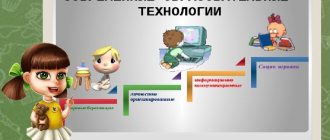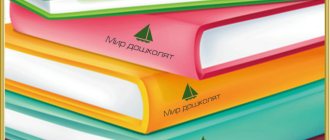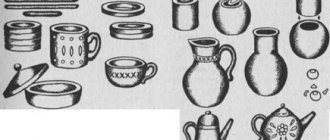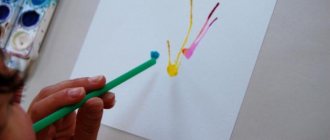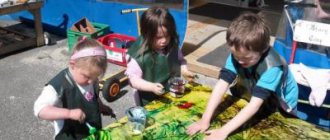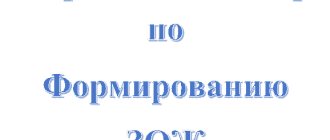Self-analysis of direct educational activities on FEMP in the preparatory group
Elena Mambetova
Self-analysis of direct educational activities on FEMP in the preparatory group
Self-analysis of educational activities directly
on the formation of elementary mathematical concepts
in the preparatory group
Goal: developing interest in the subject of mathematics, based on cognitive activity and curiosity.
Tasks:
Educational . To promote the development of the ability to apply mathematical knowledge in non-standard practical problems.
Developmental. Develop mental operations: analogy, systematization, generalization, observation, planning.
Educational. Help maintain interest in mathematics and develop the ability to work in a team.
Integration of areas: socialization, communication, health, music, reading fiction.
Preliminary work:
Guessing riddles, solving logical problems, solving simple arithmetic problems, observing the calendar, individual lessons Learning physics. a minute, board games
Organization of direct educational activities (EDA)
Educational activities were carried out in the preparatory group and lasted 30 minutes.
All sanitary and hygienic requirements were met: furniture was selected To create interest, the children went on a rocket trip to the planet Mathematics, where they completed various mathematical tasks. Directly educational activities were built in a single game plot.
Changing types of activities (game, communicative, motor)
contributed to maintaining the attention and performance of children throughout their educational activities
. Physical education was used during the activity
, visual and finger gymnastics.
Structure of direct educational activities (DEA)
In its structure, the educational activity itself is designed in such a way as to arouse and maintain interest in the subject of mathematics, based on cognitive activity and curiosity.
The first part included an organizational point: preparing for the trip . to stimulate auditory attention and perception, motivation.
The second part consisted of unique stages - completing tasks: guessing riddles, “What is extra and why?”
“Name the intended number” “Remember and do”
is an exercise for the development of auditory perception, which helped maintain the attention and performance of children throughout their
educational activities .
The third part is the result, reflection.
Teaching methods and techniques
Methods and principles are selected in accordance with educational , developmental and educational objectives.
In the course of direct educational activities, visual, verbal and practical, game methods were used, aimed at the use of cognitive, speech, motor, practical skills and abilities, and their improvement.
The proposed games were selected according to the age of the children, which contributed to the solution of the assigned tasks.
Throughout the entire activity , cognitive interest was maintained using surprise moments and games.
In the process of educational activities, educational goals were also pursued: to cultivate interest in mathematics, to develop the ability to work in a team.
Various ways of including children in the educational process : intonation of speech, emotional expressiveness.
In the process of direct educational activities, work was continuously carried out to expand and enrich the vocabulary of children.
GCD effectiveness
I believe that the set goal and objectives have been achieved.
Self-analysis of mathematics classes in the senior group
Elena Prosvetova
Self-analysis of mathematics classes in the senior group
Dear members of the jury, you have watched a mathematics lesson in the senior group called “Journey to the Land of Mathematics ”
.
Goal: to consolidate the acquired knowledge in children using educational games, to develop the ability to rejoice when achieving a goal.
Tasks:
Educational:
consolidate the ability to find a number and adjacent numbers in a number series;
consolidate the ability to compare 2 adjacent numbers using the greater than, less than and equal signs;
be able to distinguish geometric shapes by shape, color, size;
consolidate the ability to navigate in space and on a sheet of paper;
consolidate the ability to select opposite words for mathematical concepts .
Educational:
develop logical thinking, attention, intelligence, memory;
contribute to the formation of mental operations, speech development, and the ability to argue one’s statements.
Educational:
cultivate interest in mathematics , a feeling of joy from joint actions and successfully completed tasks;
develop the ability to understand the learning task and carry it out.
The lesson was carried out in accordance with the notes. The abstract was compiled independently , in accordance with the tasks of the Rainbow
for a given age of children.
To implement each task, techniques were selected in an interesting and entertaining form .
At every moment of the lesson there were visual aids that stimulated and activated the children’s mental activity. The manuals are of sufficient size and aesthetically designed. Their placement and use was rational, thoughtful in the learning space and in the lesson .
Organizational reception "Welcome"
in poetic form" was aimed at developing communicative skills, establishing friendly relationships both within the children's team and between guests and children.
The lesson is dynamic , it includes techniques that involve changing activities. The beginning of the lesson was aimed at getting the children interested and including each preschooler in the activity.
The purpose of the didactic game “Funny Figures”
is the formation of geometric vigilance in the ability to correlate the shape of objects with known geometric figures.
The following didactic game used in the lesson “Put it right”
.
Its goal is to develop children's visual-spatial orientation and elementary mathematical concepts of geometric shapes.
The purpose of the mathematical warm-up “True - False”
teach children to distinguish between true and false judgments.
The purpose of the didactic game “Name the neighbors”
consolidate the ability to find a number and its neighboring numbers in a number series.
Using physical education in the middle of the lesson helped the children relax, have fun, and relieve tension. The children were charged with positive emotions.
Didactic game “Signs asking for help”
was used to reinforce the ability to compare numbers using
mathematical symbols .
“Say the Opposite” helped us consolidate the ability to select opposite words for mathematical
.
The development of children's interest, imagination, and visual-figurative thinking was carried out with the help of the game “The Numbers Are Hidden”
.
All aspects of the lesson are logical and consistent, subordinated to one topic. At every moment of the lesson, I tried to use varied and interesting tasks, activate independence and maintain a positive emotional mood. The specifics of working with children in the classroom were reflected in a person-centered approach. She encouraged timid children and praised them in order to consolidate their situation of success.
During the lesson, I tried to communicate with the children on the same level, tried to maintain the children’s interest in the lesson throughout the entire time.
The outcome of the lesson was organized in the form of reflection and encouragement.
I believe that the program tasks I set during the lesson were solved .
Summary of an open lesson on FEMP for middle-aged children “5 Keys”
Summary of an open lesson on FEMP for children in the middle group “Five Keys”
Age
: 4-5 years
Integration of educational areas
: cognitive, speech and social-communicative development;
Target:
the formation of elementary mathematical concepts, constructive abilities, communication skills, and expand the active vocabulary of children.
Tasks:
Educational:
consolidate the ability to count within 5, introduce the ordinal value of a number, teach how to correctly answer the questions “How much?”, “Which one?”; improve the ability to distinguish and name geometric shapes: circle, square, triangle, oval, rectangle; consolidate knowledge of flowers; consolidate knowledge about the parts of the day;
continue to develop constructive skills (construct from geometric shapes).
Developmental:
develop attention and memory; consolidate the ability to correctly use generalizing concepts (classification);
Educational:
to cultivate goodwill in children in communicating with peers and adults;
Demo material:
a chest with five locks, five keys, a small glass jar with clear water, blue cloth (lake), five fish of different colors with numbers from 1 to 5; napkin, pictures with parts of the day, model of a tree, easel, “Aibolit” slides, “objects made from geometric shapes;
Handout:
hedgehogs, apples (5 pieces for each child);
Methodical techniques:
game situation, problem statement, conversation-dialogue, speech game, physical education session, experiment with water in a jar, analysis, summing up.
Secret experiment with water. In order for colored water to appear in a jar after clear water, you need to apply thick gouache to the lid of the jar. After you shake or shake the closed jar, colored water will appear in it.
Progress of the lesson
The children stand in a semicircle.
Educator:
Guys, we have guests today.
Say hello. (Greet greetings to guests).
Educator:
Guys, today a package with a letter arrived in our group. And who it came from, you will find out if you guess the riddle:
This is a very kind doctor.
The animals send him greetings.
He goes into any distance,
If someone calls.
He doesn't sit idle -
Our beloved... (Aibolit)
«Hello guys! Help me please.
Animals in Africa are sick. I took the magic water and was about to set off, but the evil pirates took my chest from me! They locked the chest with five locks and hid the keys. If you agree to help me, then you have to complete five tasks. For each task completed correctly, you will receive a key. Having collected all the keys, you can open the chest with magic water. I would go on the journey with you myself, but sick animals are waiting for me. I really hope for you! When you complete the task, send me magic water! Aibolit."
(the teacher opens the parcel, takes out the chest and looks at it with the children - there are five locks on it);
Educator:
Guys, let's help Aibolit?
( children's answer) .
Then we hit the road to the lake.
Look, fish are swimming in the lake. We need to get them. Here is our first task
. The fish must be placed in order (the teacher names the child, Find the fish with the number 1, 2, 3, 4, 5, what color is the fish number 1, etc.)
- Well done! We've done it, here's the first key!
(after each task, the children, together with the teacher, open one lock)
Task 2.
Game “Parts of the Day” (“Finish the sentence”)
- Look, what is that glittering on our tree? (key) and some bird is sitting on a tree. What kind of bird is this? (magpie) But she doesn’t want to give us the key. She prepared riddles for us. If we guess right, he will give back the key.
- Now I’m not going to read the sentence to you completely, you must finish it:
— We sleep at night, and do exercises... (in the morning)
- We have breakfast in the morning, and lunch... (in the afternoon)
- We have lunch during the day, and have dinner... (in the evening)
- We have dinner in the evening, and sleep... (at night)
- How many parts are there in a day? (4). Name them.
Educator:
Well done! You were so good at solving riddles! Here is the second key for the correct answers.
Now the third task.
Task 3.
Educator:
Children, you and I have come to the forest school. Guys, come to the tables. Sit down, keep your backs straight, legs tucked under the table (saving health - posture); There are pictures in front of you. Here's the task: post pictures of hedgehogs. How many hedgehogs did you get? (Children's answer). Right. What do hedgehogs like to eat? That's right, mushrooms and apples. Let's treat the hedgehogs with apples. (Children lay out apples). Did all the hedgehogs have enough apples? (Children's answers). How many apples do we have? How many hedgehogs? What should we do so that there are equal numbers of hedgehogs and apples? That's right, you need to add one apple or remove one hedgehog. Let the first table imagine that one hedgehog ran away, and the second table that the hedgehog found himself an apple. What have we got now? (Children's answers).
- Well done guys! Mission accomplished! Here is the third (and fourth) key (under the table where the children are sitting there is a basket with keys, covered with a napkin);
Educator:
And now it's time for us to rest. I invite you to the carpet.
PHYSICAL MINUTE
On Monday I swam (pretend swimming) And on Tuesday I painted. (pretend to draw) On Wednesday I took a long time to wash my face, (we wash my face) And on Thursday I played football. (running in place) On Friday I jumped, ran, (jump) danced for a very long time. (spinning in place) And on Saturday, Sunday (claps hands) I rested all day. (children squat down with their hands under their cheeks and fall asleep.)
Educator:
Well guys, have a rest! It's time to start the next task.
Task 4. “In the land of geometric shapes”
Educator:
Guys, let's go to the monitor and look at the slide. What do you see? (picture) What’s unusual about it? (the picture consists of geometric shapes) Let's describe it (describe the slide)
Educator:
Well done boys! For this you receive the fifth key.
So guys, how many keys do we have? (Five).
Now we have to open the last lock of the chest, open it and get the magic water.
Children and their teacher open the chest and take out magic water. (It's transparent).
Educator:
In my opinion, this is ordinary water. Wait, there's another note.
“If you shake the jar, the water will become magical. Urgently send magic water to me in Africa. And for you, kids, there’s a surprise in the chest, magic candies” (at the bottom of the chest is a treat for the kids).
Our adventure has come to an end. Let's remember what we did today? They helped Aibolit (they looked for keys - there are 5 of them), laid out the fish (how many were there? what color), guessed the parts of the day (what parts were they? morning, day, evening, night), solved a problem about hedgehogs and apples (how many hedgehogs were there? everyone were there enough apples? what did we do so that there were equal numbers of apples and hedgehogs? we found another apple and the extra hedgehog ran away), looked at a picture of geometric shapes; what figures did we meet? (circle, square, rectangle, oval, triangle) Did you like it? What did you like most? (children's answers).
- Let's say goodbye to the guests
